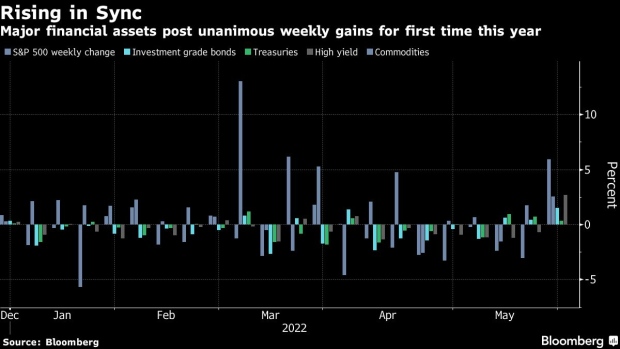May 27, 2022
Big up week for everything is latest sudden twist for traders
, Bloomberg News
BNN Bloomberg's mid-morning market update: May 30, 2022
Practically everything rose this week, with traders crawling out from seven weeks of wreckage. From speculative flyers to the bluest chips, across junk and corporate bonds to Treasuries and commodities, the path of least resistance was, for once, up.
Climbing more than six per cent over five days and nine per cent from last Friday’s low, the S&P 500 snapped the longest streak of weekly drops in a decade, notching its best rally since 2020. Returns outside equities were smaller, though the positive tone prevailed. Nearly every major asset rose, a feat not seen since December. Only the dollar and crypto declined.
While big up weeks certainly feel like relief to harried traders, they are part of a larger picture where this year’s punishing volatility is exacting a severe cost on anyone who fails to time the swings perfectly. Right now, the S&P 500 is down 13 per cent in 2022. If you subtract its five worst days, the return is 2.6 per cent. At the same time, missing the biggest five up days causes the year-to-date decline to swell to 24 per cent.
“This is not a time when you try to chase and call a bottom, call a peak, call an inflection point -- because, honestly, inflection points are happening daily,” Liz Young, head of investment strategy at SoFi, said on Bloomberg Television. “You can feel like you’re wrong on a daily basis, and that’s when you start to make mistakes.”

The meaning of high-velocity rallies is also heatedly debated. To bulls, gains of this breadth are characteristic of bottoms, a kind of mass realization that sufficient damage has been done to prices already. Skeptics say it is completely normal in bear markets for emotions (and short-covering) briefly to take over and drive prices higher in a nearly unanimous way.
“When you fall this far, it doesn’t take much for stocks to rally. And these bounces come sharp,” Joseph Saluzzi, co-head of equity trading at Themis Trading LLC, said by phone. “Problems didn’t go away for sure, but there is this optimism that we’ve found a bit of a middle ground between inflation and recession.”
Volatility has been the rule in 2022 as uncertainty over the Federal Reserve’s policy path and its impact on the economy emboldens extreme views. Earlier this month, the dominant narrative was that the central bank’s aggressive inflation-fighting campaign would spur a recession. Now, weakening data on housing and inflation, and relatively rosy minutes from when the Fed last convened, prompted traders to bet policy makers might pause or slow the pace of tightening later this year.
As investors scaled back rate-hike expectations, Treasury bonds climbed for a third week through Thursday, the longest rally since early December. Investment-grade bonds and high-yield jumped 1.5 per cent and 2.7 per cent, respectively, each scoring their best week in almost two years. Meanwhile, rising oil prices helped push the Bloomberg Commodity Index back toward an eight-year high.
Stocks were bolstered by upbeat earnings from retailers like Nordstrom Inc. and Macy’s Inc. after disappointing forecasts from Walmart Inc. and Target Corp. sparked a selloff a week earlier. A basket of unprofitable technology companies climbed 5.4 per cent over five days, ending a record seven-week decline.
“The Fed is doing exactly what it needs to do and the market is recognizing they have the tools to get it done,” JoAnne Feeney, partner at Advisors Capital Management LLC, said on Bloomberg Television. “It’s clearly the case that long-term inflation expectations are well anchored.”
Investors who dumped stocks for six weeks in a row are finding their way back to markets. They added about $20 billion to global stocks in the week through May 25, according to EPFR Global data.
There were also signs that short sellers contributed to the latest rally as they were forced to cover bearish wagers. A basket of most-hated stocks surged more than 8.1 per cent over the week, while the SPDR S&P 500 ETF Trust (ticker SPY) saw its short interest as a percentage of shares outstanding decline for seven straight days.
After the S&P 500 last week fell to the brink of a bear market decline of 20 per cent and valuations shrank back to their historical average, the urge to buy the dip resurfaced. Positioning had also gotten so low that the foundation was laid for a power turnaround. Hedge funds had cut equity exposure to multiyear lows and cash holdings at funds by some measures rose to a two-decade high.
Still, past reversals haven’t been kind to bulls. Consider anyone who bought in mid-March, when the S&P 500 surged more than six per cent over five days -- the only other jump of that magnitude in the past 18 months. They were treated to an 8.8 per cent plunge in April, the worst month in two years.
The S&P 500 rose 2.5 per cent to 4,158.24 Friday, erasing its loss for May.
To Dennis DeBusschere, the founder of 22V Research, the index is likely stuck in a range between 3,800 to 4,200 until the market gets more clarity on whether the central bank can bring inflation in check without derailing the economy. A key data point, he says, is the monthly jobs report due in a week that will shed fresh light on the labor market.
“If consumer data points are strong, they will signal financial conditions have not tightened enough and risk assets will fade,” DeBusschere wrote in a note. “We would fade the market into payroll next week and we will continue to focus on the 3,800-4,200 range until it is clearer if the opportunistic disinflation outcome is playing out.”









